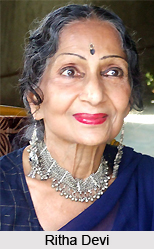 Ritha Devi is regarded as an extraordinary persona who has spread the traditional dance form Odissi in a softly radiant way. She has also been regarded as a celebrated dance critic. Today she has been counted as one of the few dancers who hail from India and exhibits the age old classical styles in their conservative and basic form. Like the contemporary legends, Indrani Rehman and Yamini Krishnamurthy Ritha Devi also possess a passion on the art form. As she said: "My passion for dance keeps me going despite setbacks in personal life."
Ritha Devi is regarded as an extraordinary persona who has spread the traditional dance form Odissi in a softly radiant way. She has also been regarded as a celebrated dance critic. Today she has been counted as one of the few dancers who hail from India and exhibits the age old classical styles in their conservative and basic form. Like the contemporary legends, Indrani Rehman and Yamini Krishnamurthy Ritha Devi also possess a passion on the art form. As she said: "My passion for dance keeps me going despite setbacks in personal life."
Ritha Devi was born and brought up in an environment where she has seen all the luxuries in life. She is the daughter of a senior councillor in pre-independent India of the then Baroda state. Raitha Devi shares a good relation with legendary Nobel laureate poet Rabindranath Tagore and Lakshminath Bezbaruah. Lakshminath Bezbaruah is considered as the father of modern Assamese literature. Ritha Devi apart from being a noted dancer has also graduated in English and Sanskrit from the University of Bombay. But she shapped her life according to her devotion towards dance.
Ritha Devi`s love for dancing was never appreciated by her family. She had to experience her fathers anger as she wanted to learn dancing. Her father to teach her a lession stopped funding her higher education. She has been married off to a husband for whom dance is something that people from decent background never do. It was supposed to be the shameful conduct for the people who comes from those family background. But Ritha Devi was already fallen in love with dance. As she recalls, "Seeing the great Uday Shankar dance, I fell in love with dance instantly and the day I watched the goddess-like Rukmini Devi, I decided to be a dancer".
As a result Ritha Devi had to leave her husbands house with a son. But this determined classical dancer still continued to learn different dance styles. Her luck favoured to her as she got the opportunity to be trained under some of the best advocators of her time. Ritha Devi received training in Manipuri from Howbom Athomba Singh at Kolkata, Bharatnatyam from Pandanallur Chokkalingam Pillai in Chennai, Mohiniyattam from Kalamandalam Lakshmi and Kathakali from Asan Karunakaran Panikkar in Mumbai, Odissi from Pankaj Charan Das in Puri and Kuchipudi from Vempati Chinna Satyam. Apart from these she has also learn Kathak and Sattriya.
After her performance in Europe, Ritha Devi has also executed her performance in the US. She has also toured extensively in the Soviet Union. Later on New York University invited her to teach Indian Dance for 10 years. Acknowledging her talent she was felicitiated with three fellowships from renowend highly esteemed American cultural bodies for undertaking choreography. The archives of the National Endowment for the Arts have preserved her valuable works.
In due course, Indian classical dance scenario in India has undergone many changes. A drastic wave of transformation has brought about a change in the domain of dance.. By that time Ritha Devi came back to India from US. To settle down her first choice was Mumbai, as it possesses a good dance circle. But Mumbai was an expensive city to reside on. In addition to that she had undergone an accident that caused damage in one of her knees. She had to shift to Pune. Ritha Devi still practices dance for three hours daily. Along with that she regularly attends dance festivals, edits dance journals and even teaches dance.



















